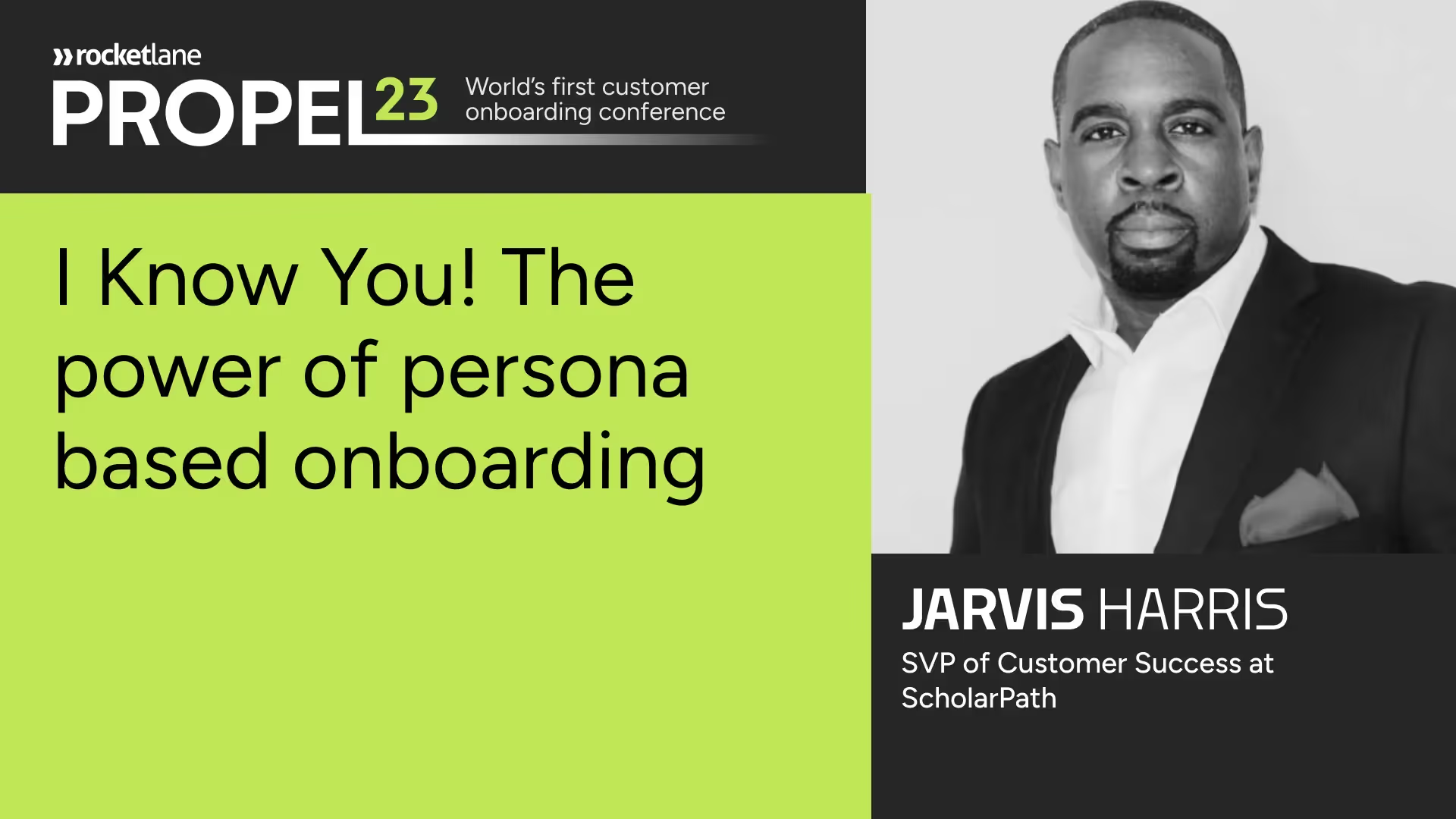More resources
- Explore our previous year's and current year’s Propel recordings
- Check out our Implementation Stories for best practices from the most efficient implementation teams out there
- Take a look into some of the insightful discussions happening in our community - Preflight Conversations
- Listen to our podcast for all things customer onboarding - The Launch Station
- Get more customer onboarding resources from Rocketlane here
At Propel23, Jarvis Harris, the Chief Customer Officer at Scholar Path and an expert in customer experience explored the importance of defining personas for different customers and developing a persona-based onboarding framework to achieve a personalized customer onboarding experience.
In this session, Jarvis spoke about:
- Why customer personas matter in onboarding and how to identify them
- The three major customer personas
- The customer onboarding triggers one should keep in mind
- Applying a personalized onboarding process for a seamless and successful persona-based customer onboarding experience.
Here are the major takeaways and key points from the session.
Why do customer personas matter during onboarding?
Once a customer buys our solution, we focus on finding a value proposition or purchase story. From there, we prioritize implementation to ensure they see a return on their investment and gain first value. However, a crucial aspect of this process is maintaining a strong customer relationship. Whether you work in customer support, professional services automation, or customer success, building a solid foundation with your customers is essential. This foundation allows for a seamless experience without room for errors, blocks, or issues.
A not-so-good relationship with the customers often creates a crunch, which doesn’t bode well in the long journey ahead. That's why it's important to start building a solid relationship from the start, ensuring that both parties understand each other.
Here, Jarvis focuses on the four fundamental reasons why customer personas matter and how persona-based customer onboarding is better.
1. To understand the customer’s needs, experiences, behaviors, and goals
Personas help us know our customers better by understanding their needs, the experience they get, their goals, and their behaviors. Beyond the customer information you get from the sales team, defining their personas by understanding their needs and pathways plays a key role in designing and formulating an ideal and appropriate experience for our customers. Defining personas by individual roles rather than the company is important because it gives us clarity and understanding about our customers and results in enormous value to the company.
2. To recognize and understand our customers’ uniqueness
As the saying goes, one size does not fit all; the experience we provide our customers needs to be targeted and personalized but not customized. Providing a tailored, personalized experience differs from giving customization to your customers, as personalization focuses on highlighting the uniqueness of each customer, while customization may overlook this aspect. The key factor we should understand when it comes to persona-based onboarding is recognizing every customer’s uniqueness. It helps us gain clarity on every customer’s specific needs and also on the specific industry trends. These help us formulate a tailored and personalized onboarding experience to drive value for our customers.
3. To promote better two-way communications with customers
A customer relationship is truly established only when the communication is bi-directional. It is important to have back-and-forth communication as it allows us to comprehend the customer's preferred communication style. The type of communication a customer expects can differ depending on customer personas. For example, some customers might be interested in many details and intricacies, while others may prefer to know the surface-level status of the matter. This is why building a persona-based customer onboarding helps you scale faster.
4. To target our customers’ experience and ultimately maximize customers’ ROI
Understanding the target customer persona helps significantly reduce time by not building something that’s low in providing outcomes. The customer's ROI maximizes as the time spent outside specific customer outcomes significantly reduces.
Defining our customer persona types - The 3Ds
Jarvis Harris defines customer personas as the 3Ds: Dreamer, Driver, and Doer.

The 3Ds play a crucial role in building and maintaining customer relationships. The specific implementation of the 3Ds can vary across different accounts, depending on factors such as size, segmentation, business model, ARR (Annual Recurring Revenue), and MRR (Monthly Recurring Revenue). However, at least one or two of these components will typically be included in the onboarding or customer journey.
Identifying these three persona types is crucial as it allows for a targeted approach, utilizing specific processes, tools, cadence, and playbooks that align with each customer persona.
1. The Dreamer
The Dreamer is someone who serves as an executive sponsor. They are not only responsible for signing financial checks and managing budgets. They also conceive ideas and understand the purpose of the idea, product, solution, or platform. Dreamers are key individuals who holistically drive progress. Typically, these Dreamers are high-level executives who initiate organizational change and transformations. It is extremely important to identify a Dreamer because the lack of them eventually results in the risk of churn. So, it is crucial to ensure that you’re bringing forth what a Dreamer needs, as they are the reason you exist and hold the necessary financial resources.
2. The Driver
Drivers are orchestrators who take you to the finish line. They can fulfill various organizational roles, such as project managers or frontline managers. Their main responsibility is to oversee the progress of a project or product. They don’t necessarily have budget responsibilities and usually manage the individuals responsible for executing tasks and delivering desired features and functions. Drivers are important because they will coordinate the resources and drive your solutions or onboarding. The drivers will ensure that things are moving forward and that there are no roadblocks or anything that impedes the progress flow of the customer onboarding process.
3. The Doer
The Doer is the person who collaborates with you to ensure that implementations are carried out correctly and configurations are done accurately. Their main focus is to ensure that users receive what they need. Doers play a crucial role in the customer onboarding process and are considered frontline individuals. Despite not being directly responsible for budget sponsorship or holding managerial positions, they are essential in ensuring the successful functionality and usage of high-quality features. The time spent working with doers surpasses that spent with Dreamers or drivers. Building a strong relationship with the doer is critical during the customer onboarding and implementation process, as users typically reach out to them first. When doers are empowered and given the necessary tools, they can empower the entire user base.
These are the three important and unique levels of customer personas, and they should be a company-wide approach. They make up a unique, unified, and powerful customer team, and it will make you different from every competitor. Identifying these personas and building a plan for each level will drive values and early renewals.
Customer Onboarding triggers: What buttons to push based on the persona
Jarvis explains the triggers in the customer onboarding process and what buttons one should push, considering the different personas involved.
The Dreamer
Regarding Dreamers, minimizing the number of meetings they participate in is essential since they already have a full plate managing budgets, personnel, and company assets. Instead, opting for a well-organized kickoff meeting and concise spotlight summary reports would be preferable. Jarvis Harris describes these reports as status updates or updates that provide a higher-level overview of progress toward achieving value. Dreamers usually give importance to first value and time-to-value. The spotlight report will focus on the first value, the progress levels, and the how, when, and what of the first value.
The Driver
Drivers want to ensure the plan and project go smoothly at all levels. As the doers are the middlemen working it all out, they will need to know if things are flowing or if any blockers are in the way. Since they interact with stakeholders and are closely involved in the project, it is crucial to communicate with them regarding timelines, resource requirements, expectations, and any other needs. Essentially, they need answers to the questions: What are the goals, what is the desired outcome, and what resources are necessary to achieve them?
The Doer
Doers often expect project transparency. It includes delivering everything on schedule, meeting deadlines, and making individuals feel valued. When it comes to doers, spending a lot of time with them and diving in to form an intimate business relationship makes them feel comfortable and ensures no hidden agendas. A clear relationship with the doers, which includes more frequency and conversation, helps identify goals clearly and drive them to value.
Drivers and Doers
Jarvis mentions additional factors that can trigger a positive response, such as demonstrating intentionality, having an organized approach, and having a targeted approach. These triggers can be effectively utilized by ensuring a strong first impression. Jarvis also introduces the concept of Lifetime Reports, which function like Gantt charts or project timelines and assist in effortlessly tracking project progress. Delivering targeted solutions based on specific requirements makes it easier to leave a favorable first impression consistently.
Essential components for successful persona-based customer onboarding
Personalized customer onboarding experience
Creating a personalized onboarding experience gives the customer a sense that it was custom-made for their needs and helps them achieve their goals. While designing unique experiences for different customers may require significant effort, the payoff is worth it. Once you grasp the entire process, it becomes easier to make adjustments based on individual customer feedback. Your role is crucial in driving this personalized onboarding experience, which applies to all types of personas: the Dreamer, the Doer, and the Driver.
Effective personalization demands a well-structured roadmap for onboarding and ongoing project management. Rocketlane's project templates enable you to efficiently schedule and oversee your entire project plan. Get a free demo today!
Automate 50% of your communications
Typically, communication is 50-50 between the Doer and the Driver. However, with Dreamers, communication will be tailored to their specific preferences and frequency. By automating 50% of your communication, you can minimize the need for constant meetings, Zoom calls, or being physically present at client sites. Mixing it up and automating certain tasks, such as sending emails or utilizing CRM tools like Hubspot or Salesforce or CS tools like Gainsight, churnzero, or Tango, can greatly streamline your communication process.
Forecast potential changes
It is important to assess potential challenges that may arise during the onboarding process for Drivers. Doing so will enable you to address and resolve them proactively. By giving Drivers the authority and resources necessary to connect with stakeholders and manage the internal workflow, they can effectively remove roadblocks and maintain momentum. Therefore, emphasizing the importance of forecasting potential challenges specific to the driver role is critical.
Key takeaways
To conclude, according to Jarvis, the process of having a successful persona-based onboarding includes:
- Understanding customer personas and defining them according to the customer needs and requirements.
- Identifying the onboarding triggers according to the different types of customer personas.
- Understanding that personalized onboarding experience for customers and forecasting potential changes will help increase the success and renewal rate.















